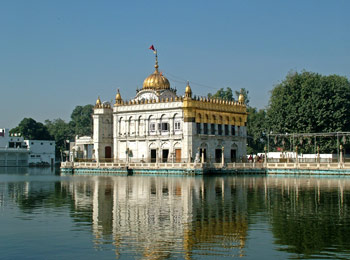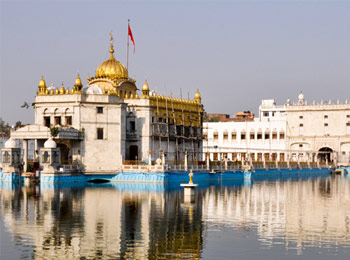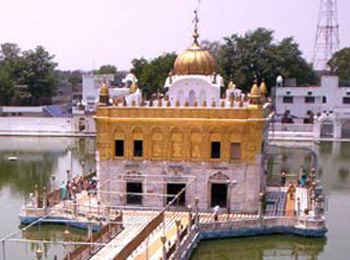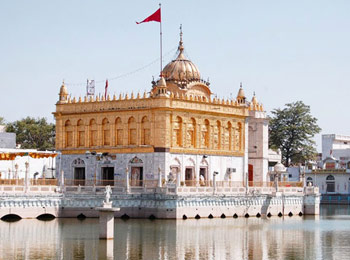- Others
Durgiana Mandir
- Amritsar,Punjab
- View on map
- Tell us about this temple
Overview
The Durgiana Temple, also known by other names of Lakshmi Narayan Temple, Durga Tirath and Sitla Mandir, are premier Hindu temples of Punjab (India) situated in the city of Amritsar. Though a Hindu temple, its architecture is similar to the Golden Temple of Sikh religion. This temple derives its name from the Goddess Durga, the chief Goddess deified and worshipped here. Idols of Goddess Laksmi (goddess of wealth) and Vishnu (the protector of the world) are also deified here and worshipped.
About The Temple
Durgiana Mandir, an important religious pilgrimage of The Hindus is in the North of India. It is situated in Amritsar City ofPunjab State. It is a few yards away from Railway Station and about 1.5 km. from the Bus Stand. This City of Amritsar is pious, as it was visited by Lord Rama, Maryada Parshotam. Luv and Kush spent their childhood along with their mother Mata Sita on this soil in the Ashram of Maharishi Valmiki. King Ishvaku Grandson of Surya Devta performed a number of Yagya on this land. The City of Amritsar was however established by the fourth Guru of Sikhs Sh. Amar Dass Ji. This religious and pious place of the Durgiana Mandir is managed by Durgiana Committee (Regd.). The Trust utilizes the offerings of the Temple and other resources for the various activities for the welfare of the society irrespective of religion, caste and creed. Gods and Goddesses of the Hindus i. e Lakshmi Narain, Lord Rama, Sita, Lakshman, Bharat, Radha Krishna ji, Shree Hanuman ji, Lord Shiva and Satnarain, are in existence here. There is a continuous flow of devotees throughout the day till late in the evening. The blessings of the Gods fulfill the desires of all. The main temples and other religious activities of the Mandir Complex are described in brief below.
Shree Lakshmi Narain Mandir

This is the main Mandir. The concept of building this beautiful temple on the pious soil of Amritsar City was conceived in 1920. Pandit Madan Mohan Malviya, the great Hindu philospher, reformist and Karamyogi was instrumental in collecting funds for this noble cause. Sh. Guru Har Sahai Mal Kapoor and Sh. Nathu Mal Rang Wale, both made tremendous efforts for raising funds and for planning. Ultimately on 7th october 1925, Pandit Madan Mohan Malviya laid the foundation of this temple on Dussera Day i. e. Ganga Dasmi. Guru Harsh Sahai Mal Kapoor is sitting in worshiping posture facing the temple. Main Gate of the Temple is of Silver of 12*12 ft followed by Darshni Deori. On the left and right in the deori are the idols of Maa Durga and Ganesha to bless the devotees. The whole Temple is in water. The approach to the temple is through the bridge of 18. 5. From the bridge the Lakshmi Narain in standing posture is touching the heart of everybody. The idols are clam and so attractive that one cannot resist sitting before Him for long duration. On the left of this temple is Ram Darbar and on the right is Radha Krishan along with Govardhan Maharaj. The architectural design and structural work is well planned. Even after seventy five years of its construction, there is no sign of its wear and tear. One can sit in Dhyan in front of these idols and can get peace. The environment is extremely calm and quiet. The walls and roofs are beautifully decorated with gold sheets and other fine art works in multicolor. The terrace has a big tomb with four number tombs on each corner of terrace with a dozens of small tombs, all these are Gold Plated. On the rear of this temple is Harkipori where the Lord Shiva is sitting in Dhiyan posture and is in the sarover. On its left and right are Krishan Balram and Ved viyas ji. The water from this place is Amrit and has medicinal characteristics. Two portrates one of Lord Krishna touching the feets of Sudama and the second of Kevat . On the corners on this temple is Garud-. The whole temple has well planned lightening arrangement which makes the temple extremely beautiful and attractive at night. All gates in this temple i. e nine Number are of silver and are a piece of art. Rasoi exclusively for these Gods and Goddesses is visited by none other than Mandir Pujari is being run by the Committee. Arti is recited five times a day as per Hindu religious culture.
Bara Hanuman Mandir

This Temple is in the north western side of the main Temple. A passage from the parikrama leads to the back side of the Temple. As per historical facts, Lord Rama performed Ashwamegh Yagya. A horse was allowed to pass through the territories under the rules of the King. The horse passed whatever area that was considered under the rules of the king. During this exercise, Lov & Kush caught hold the horse. When Lakshman, Bharat and Satrughan tried to liberate the horse, they fell unconscious during the battle. Even Hanuman ji was also captured and tied at this place. Luv and Kush when knew about the relations with all these, Amrit was brought from the Devtas, With the help of this Amrit unconscious Lakshman ,Bharat and Satrughan along with their Army were brought to their consciousness . The left out portion of the Amrit was dumped in the soil of Amritsar. This is how the name of Amritsar originated. It is hardly 4kmt as crow flight from the Maharishi Valmiki Ashram. It is a legend that Hanuman ji visits this Temple regularly. For a person who visits this Temple daily all his/her desires are fulfilled. The idol of Hanman ji in this Temple in sitting position is next only to Ayodya. It is a huge idol. In the Temple is a Shiva Temple on a raised platform. A big room for kirtan and recitation of Ramayan is also there. At this place people from all walks of life within the country and from abroad visit this Temple during Navratras. The couples who get male child with the blessing of Hanuman ji dress up their children as langoor, Sena of Lord Rama. The dressed up kids dance in this Temple to the tune of drums. The area of the temple has been extended and the whole flooring etc have been covered with white stone.
Mata Shitla Mandir

This temple is more than six hundered years old. The idol of Shitla Mata (Durga Mata) is situated in the centre of the square yard area. Facing the Maa Durga is lion of brass in standing position and a temple of the ling of Lord Shiva in a small temple of about 6.5 ft. in height. In the rear of this temple is an old beri. It remains green throughout the year. Devotees worship this tree and get their desires fulfilled. Devotees also visit this temple for getting treatment to cure various ailments of their children by taking Charnamat from this temple. It is said that Mata Sita used to visit this temple of Durga Mata to perform puja The Temple is about four km. as a crow flight from the Ashram of Maharishi Balmiki where Mata Sita spent last years of her life. During the pious Navratras, Lacs of people visit this holy temple from whole of the country as well as from abroad. In the last three years, present Durgiana Committee has renovated this Temple. All the walls have been decorated with Models and pictures of Gods & Goddesses of Durga Mata in various Swaroops. Rooms have been erected so that Sadhus and Saints could stay during their visit to the Temple.
Parikarma: The Sarovar
The main temple is in the centre of the sarover which is 542/528 ft. and is18 to 20ft. deep. The sarover is surrounded by a passage of 700 * 7 yds used as parikrma by the devotees. In the start, towards the right of the main gate is ShivTemple. After this temple, there is Bathing Ghat for ladies. In the periphery of the sarover, there a small temple of Satnarain, Virat Sawroop of Krishna and Hanuman Ji in Vishal and small Sawaroops. The whole peripheri floor is in white marble stone which increases the beauty of Temple Complex. The model and portrait are the work of real art and has the background of the Hindus religious legends. The sarover is filled with water brought from the U. B. D. C. canal from River Ravi about 5 kms from this sarover. The light green colour of the sarover water is a beauty to watch. It has a good number of fish of various types. The sarover base is cleared of silt etc. in the form of Karseva by the Devotees. So for two number Karsevas have been carried out in 1995 and 1999. The sarover had three fountains, the water in the Temple and its reflection during the evening in the presence of electric lights is worth watching. The water movement at the surface of the water in the tank travels the whole day in riples. In the absence of canal water the tank is filled with ground water drawn by the tubewells. Water from the washing of the floor or any other source is not allowed to enter Sarover and is disposed of from the disposal drain built for the purpose in periphari of the Sarover.
Shree Sat Narain Mandir
Here Sat Narain story is recited on every Purnima. The idol of Sat Narain and Radha Krishan are established here. This Temple is quite old. From the city side that is Lohgarh gate/Andhvidhalya, this is the first Temple in the complex. Just adjacent to this Temple, Krishna is showing its virat swuaroop to Arjuna in the battle field of Kurukshetra. Just adjacent to this is the big beautiful idol of Hanuman ji lifting the mountains having sanjivini Buti along with that in mini posture. In the parikarma on the left side there are ten idols which are a piece of rare art. These throw light on the religious and spiritual actions of Hindu Gods. The following idols in sequence are presented here. These remind about the great action of Hindu Gods.
1. Tulya Dan of Rukmani and Satyabhama
2. Lakshmi and Narain on snake bed in the ocean
3. Shiva is narating Parvati the technique to get salvation.
4. Chatayna Prabhu is reciting the Almighty.
5 Dhrubh is getting the Darshan of Narain.
6. Salvation of Ahilya
7 Nursingh Avtar
8. The four sons of Brahma
9. Lord Rama is taking ber from Sabri
10. Maharishi Balmiki teaching Lov & Kush.
Mandir Goswami Tulsi Dass
This Temple is in the extreme rear of the main Temple in the Parikarma. It has two openings one towards the sarover and the other on the main roads towards Govindgrah fort. Idols of Sant Tulsi Dass is placed here where as Radha Vallabh is placed at an elevation to the Sant. The Temple was erected by Pandit Chaman lal in 1960. In the Temple, handwritten Ram Nam in crores is stored. The temple has hand written Ramayan also. Ramayana is recited here daily. It has a seating capacity of about one thousand devotees.
Ved Katha Bhawan
It is on the left side on the main tample with its main gate opening towards the sarover. It was constructed with the efforts of Nathu Mal ji rang wale. Its foundation stone was laid by Swami Gangeshwara Nand on 3 november 1946. It has a beautiful stage for delivering the Gyan to the devotees. The Bhawan has sitting capacity of about one thousand devotees. Throughout the year, Saints and Gurus visit this place to deliver the religious Gyan to its devotees. The Bhawan has water and toilet facilities. Rass lila is played here by the groups of devotees from Vrindavan and on the Holi days, Indian Music festival is celebrated here.
Langar Bhawan
Next to Ved Bhawan in the parikarma is langar bhawan. It is on the left side of the main mandir. Daily langar is served to pilgrims who visit this holy temple during the day and in the evening. It has a capacity of arranging langar to 250-piligrims at a time. The Durgiana Committee bears the entire cost of running the langer. It costs more than Rs. 20 thousand monthly. The kitchen & dining hall, are Modern The foods served is nutritive, balanced & tasty repaired from desi Ghee.
About the Deity

Dedicated to the goddess Durga, this 16th-century temple is a Hindu version of the Golden Temple. Surrounded by a holy water tank, it’s often called the Silver Temple because of its exquisitely engraved silver doors. Soothing bhajans (devotional songs) are sung here just after the temple opens and just before it closes.
Festivals
Major Hindu festivals celebrated in the temple are Dussehra, Janmashtami, Rama Navami, and Diwali.
Accessibility
Airport
Flights to Delhi operate from the Raja Sansi Airport, which is 12 kilometres (7.5 mi) to the north west of Amritsar.
Railways
There are direct rail links to Delhi, Calcutta and Mumbai from Amritsar.
Road
The National Highway No. 1 (India) connects Delhi to Amritsar.
Temple Address
Durgiana Temple,
Hathi Gate, Goal Bagh,
Amritsar, Punjab - 143001.
Significance
Devotees visit this temple to seek fulfillment of the following:-
- Trouble-free marital life
- Removal of physical ailments
- Freedom from economic Problems
- Fearless disposition
Shlokas
Tribhirgunamayairbhavairebhih Sarvamidam Jagat Mohitam Nabhijanati Mamebhyah Paramavyayam
Meaning -According to this sloka, the entire world doesn't recognize the eternal God beyond them, because they are consumed by the elements of satva, rajas and tamas (good, obssessive and dark).
Daivi Hyesa Gunamayi Mama Maya Duratyaya Mameva Ye Prapadyante Mayametam Taranti Te
Meaning -According to this sloka, the heavenly maya of God is very complicated, but those who worship God will be able to overcome it.
Balam Balavatam Caham Kamaragavivarjitam Dharmaviruddho Bhutesu Kamo'smi Bharatarsabha
Meaning -According to this sloka, God is the isolated and aloof strength of the controlling and virtuous craving in men.
Ye Caiva Sattvika Bhava Rajasastamasasca Ye Matta Everti Tanviddhi Na Tvaham Tesu Temayi
Meaning -According to this sloka, though the only source of satva, rajas and tamas (good, obsessive and dark) elements is God, they are not present within the God or the deity.
